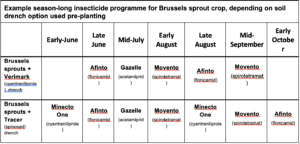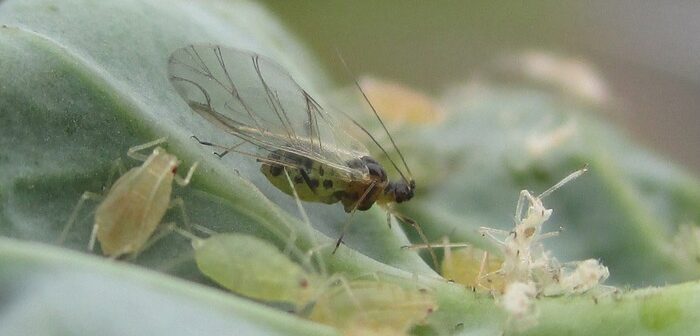Brassica growers should look to keep all remaining foliar insecticide options open for the difficult challenges to come through the growing season, advises Syngenta technical manager, Simon Jackson.
For most crops, choosing to use cyantraniliprole as a drench during plant raising could leave serious gaps in the crop protection portfolio later in the season, he warned.
That will be particularly apparent with current forecasts of a relatively early start to the aphid migration movement. At Broom’s Barn in Suffolk, for example, it was predicted to be the 12th earliest year for peach potato aphid (Myzus persicae) on the wing in over 50 years of records, with northern counties and Scotland seeing even earlier attacks.
“Aphids will be flying around two weeks earlier in Scotland and northern England and up to a week earlier over much of southern England, compared with when they would be expected historically.

Simon Jackson
“Early aphid emergence and higher than average aphid numbers could increase the risk of virus infection,” advised Simon. Infection early in the growing season typically has greater effect on plant health, vigour and final yield quality.
Although peach potato aphid typically exhibits the classic mid-season crash, where numbers drop significantly through late July, cabbage aphid has, for the past few seasons, continued to migrate into crops throughout the summer.
On crops such as Brussels sprouts, where virus would rarely be seen to be having a visual effect, growers would consider using spinosad as a drench for Cabbage root fly control and thus increase the number of foliar insecticide applications.
“Gap analysis of growers’ insecticide programme options for Brussels sprouts and cabbage show just how important a role Minecto One plays in maintaining a season-long protection programme from mid-June through to early October, especially with more open autumn conditions favourable for prolonged aphid activity.
“To enable the use of Minecto One, brassicas must not have been treated with cyantraniliprole as a plant drench during raising,” he advised. “Where growers have opted to use spinosad (Tracer) as a dench, then they can come straight in with Minecto One as a first spray for foliar pests earlier in the programme.”
The focus on the earliest foliar applications has become more intense since the loss of neonicotinoid seed treatments, with growers reporting increased issues of early aphid virus transmissions from less effective drench treatments.
Alternate modes of action
“With the option for two Minecto One applications in a programme, along with two fast-acting Afinto treatments and two applications of spirotetramat, for example, agronomists can alternate modes of action with each application for good resistance management and achieve protection right through the season,” he advocated. Afinto stops feeding and reduces virus transmission, however aphids may remain active for a few days before mortality due to the mode of action.

Utilising spinosad drench, followed by an initial Minecto One, along with a second application mid-season, will also give growers a more effective option for thrip, beetles and whitefly later. In field trials the addition of a methylated rapeseed oil with Minecto One has been shown to increase activity on sucking pests. Whitefly, in particular, has been seen to be active well into November in recent years, Simon pointed out.
For short-season broccoli and cauliflower brassicas, with a sub 90-day growing cycle, spirotetramat should provide sufficient coverage for the year, he suggested. Furthermore, for production of storage cabbage, where early virus infection can lead to internal quality issues, the use of cyantraniliprole as a plant drench prior to planting out could prove a sensible precaution, but would be more reliant on the Afinto applications in early July and mid-August to boost protection.
This season there is a new EAMU for the use of Minecto One on kale and collards for control of diamond back moth (Plutella xylostella) and other caterpillar species, along with control of flea beetle (Phyllotreta sp) and cabbage stem flea beetle (Psylliodes chrysocephala) on oriental cabbage. Growers are reminded that EAMUs are also in place for thrip and leaf miner in leeks, with full details of all EAMUs on the HSE website.




